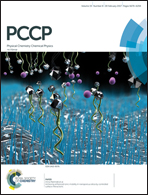Asymmetric response of ferroelectric/metal oxide heterojunctions for catalysis arising from interfacial chemistry†
Abstract
Recently there has been interest in the use of ferroelectricity to modify a material's surface chemistry and enhance its catalytic properties. When a metal oxide catalyst is supported by a switchable ferroelectric underlayer, modifications to the free surface electronic structure can induce changes to the free energy profile of a gas–surface catalytic reaction that either promote or suppress the reaction. The modification of surface properties results from a combination of interface chemistry, surface reconstructions involving adsorbates, and complex interactions between the two, although these interactions are often not characterized in detail. Using the oxygen evolution reaction (OER) on barium titanate/anatase (BTO/TiO2) heterostructures as a case study, we use density functional theory to determine how the OER Gibbs free energy profile depends on the polarization of the ferroelectric and the number of TiO2 monolayers. For positive polarizations, the profile is found to be sensitive to the number of TiO2 monolayers, shows extended finite size effects, and deviates substantially from that of unsupported anatase. For negative polarizations, the monolayer dependence is suppressed and the OER profiles remain similar to that of unsupported anatase independent of the number of TiO2 monolayers. To understand the origin of the differences, we analyze in detail the layer-by-layer rumpling, interface chemistry, surface reconstructions, and interface and surface dipoles. The unbalanced response to negative and positive polarizations is shown to arise from the underlying chemistry of the BTO/TiO2 interface. While the interfacial bonding is largely fixed for negatively polarized systems, it is variable and can be tuned by the presence of nearby surface adsorbates for positively polarized systems. The asymmetry limits the effectiveness of the heterojunction. While positively polarized systems are good candidates for the selective enhancement of catalytic reactions involving negatively charged species at the metal oxide free surface, the negatively polarized systems do not effectively enhance catalytic reactions involving positively charged species. Our work points to interface design rules to overcome this limitation and realize heterojunctions with enhanced catalytic functionality.


 Please wait while we load your content...
Please wait while we load your content...